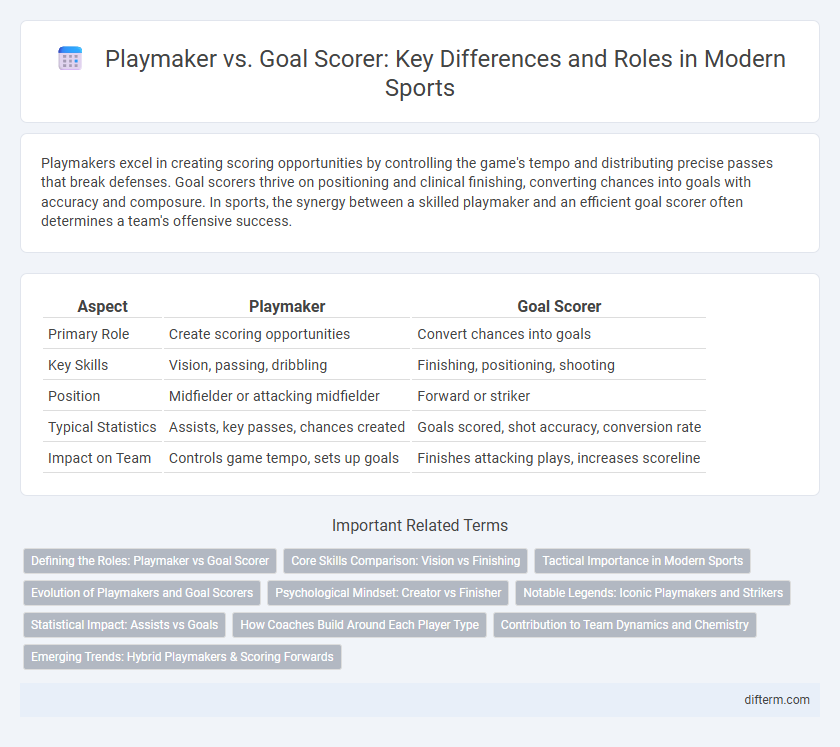Playmakers excel in creating scoring opportunities by controlling the game's tempo and distributing precise passes that break defenses. Goal scorers thrive on positioning and clinical finishing, converting chances into goals with accuracy and composure. In sports, the synergy between a skilled playmaker and an efficient goal scorer often determines a team's offensive success.
Table of Comparison
| Aspect | Playmaker | Goal Scorer |
|---|---|---|
| Primary Role | Create scoring opportunities | Convert chances into goals |
| Key Skills | Vision, passing, dribbling | Finishing, positioning, shooting |
| Position | Midfielder or attacking midfielder | Forward or striker |
| Typical Statistics | Assists, key passes, chances created | Goals scored, shot accuracy, conversion rate |
| Impact on Team | Controls game tempo, sets up goals | Finishes attacking plays, increases scoreline |
Defining the Roles: Playmaker vs Goal Scorer
Playmakers orchestrate offensive plays by creating scoring opportunities through precise passes and strategic vision, often acting as the team's creative hub. Goal scorers capitalize on these opportunities, exhibiting exceptional positioning and finishing skills to convert chances into goals. Understanding the distinct responsibilities of playmakers and goal scorers is essential for optimizing team dynamics and offensive effectiveness in sports.
Core Skills Comparison: Vision vs Finishing
Playmakers excel in vision, demonstrating exceptional ability to read the game, anticipate teammates' movements, and create scoring opportunities through precise passing and strategic positioning. Goal scorers prioritize finishing skills, showcasing clinical accuracy, composure under pressure, and an instinctive ability to convert chances into goals. The core distinction lies in a playmaker's creative orchestration of play versus a goal scorer's decisive execution in front of the net.
Tactical Importance in Modern Sports
Playmakers dictate the tempo and create scoring opportunities through vision and precise passing, shaping the team's offensive strategy. Goal scorers finalize attacks with clinical finishing, turning chances into goals and directly influencing match outcomes. Balancing these roles enhances tactical flexibility, allowing teams to adapt to diverse opponents and dynamic game situations in modern sports.
Evolution of Playmakers and Goal Scorers
The evolution of playmakers and goal scorers has reshaped modern football tactics, with playmakers increasingly adopting versatile roles that blend creativity, vision, and goal-scoring ability. Contemporary playmakers now contribute more directly to scoring opportunities, while traditional goal scorers have developed enhanced tactical awareness and playmaking skills to support team dynamics. This shift reflects the growing demand for multi-dimensional players capable of both orchestrating attacks and finishing chances effectively.
Psychological Mindset: Creator vs Finisher
Playmakers thrive on vision, creativity, and strategic thinking, enabling them to anticipate opportunities and orchestrate team play with precision. Goal scorers possess a relentless focus, confidence, and resilience to seize scoring chances under pressure, embodying the mentality of a finisher. The psychological mindset of creators centers on collaboration and innovation, while finishers prioritize decisiveness and self-assured execution.
Notable Legends: Iconic Playmakers and Strikers
Notable legends in football such as Diego Maradona and Xavi Hernandez exemplify iconic playmakers known for their vision and precise passing that orchestrated team attacks. In contrast, goal scorers like Pele and Gerd Muller are celebrated for their clinical finishing and unmatched ability to convert opportunities into goals. The distinction between playmakers and strikers highlights how creative midfield maestros and prolific forwards have shaped football history through their specialized roles.
Statistical Impact: Assists vs Goals
Playmakers influence the game primarily through assists, creating scoring opportunities and enhancing team dynamics with high key pass and chance creation metrics. Goal scorers, on the other hand, deliver measurable results with goals, conversion rates, and shot accuracy driving team success. Statistical impact varies by role, with assists highlighting creative contribution while goals emphasize final execution and match-winning ability.
How Coaches Build Around Each Player Type
Coaches design strategies by leveraging the distinct strengths of playmakers and goal scorers, emphasizing playmakers' vision and passing to control tempo and create scoring opportunities. Tactical approaches for goal scorers prioritize positioning, finishing skills, and exploiting defensive weaknesses to maximize goal output. Balancing formations often involves assigning supporting roles to optimize both creative playmaking and effective goal conversion.
Contribution to Team Dynamics and Chemistry
Playmakers enhance team dynamics by orchestrating offensive plays, creating scoring opportunities through precise passes and strategic vision that unify player movements. Goal scorers convert those opportunities into points, delivering crucial finishes that boost team morale and performance consistency. Their complementary roles drive team chemistry by balancing creative buildup and effective execution, essential for cohesive and successful gameplay.
Emerging Trends: Hybrid Playmakers & Scoring Forwards
Emerging trends in soccer highlight the rise of hybrid playmakers and scoring forwards who combine creative vision with lethal finishing skills. These versatile players disrupt traditional roles by orchestrating attacks while consistently converting chances, enhancing team dynamics and tactical flexibility. Analytics reveal that such hybrids significantly boost goal contributions and chance creation, redefining positional expectations in modern football.
Playmaker vs Goal Scorer Infographic

 difterm.com
difterm.com